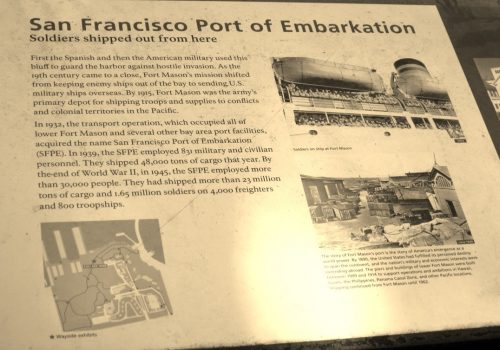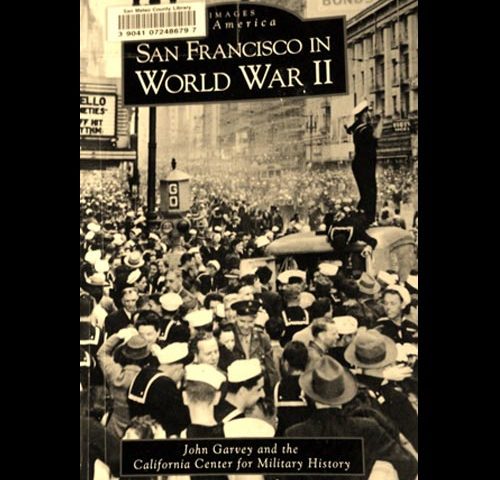Seeking My Father in San Francisco

Fourth of July Perspective
July 5, 2017
My Day at the National Archives
July 19, 2017Uncovering another clue in the quest for traces of him, I pause in gratitude for this simple find. Pages of the book quickly open revealing others like him and the yellowing photographs add depth, color and meaning to those dark times. He was here, but where and what did he do?
A determined, quickly-built ship deliberately carried him from this familiar shore. But has time now erased any remaining evidence of his presence? There must still be some reminders of his short stay, yet I fear they will remain locked in the vaults of the city’s historic past.
Eager to know, I can’t turn back now. That gnarly rope of curiosity keeps pulling me to new, strange and unfamiliar locations. When I turn an unsuspecting corner will there be another slightly hidden clue waiting to greet me.
The search continues propelled by the magnetic force of a daughter seeking to know her father.
JJE 6/30/17
Searching for clues about my father’s World War II service is a never-ending and often uncharted journey. It is like a world-wide scavenger hunt, but with unclear and obtuse directions. When I find a relevant piece of information, I often discover another surprising detail that I didn’t even realize was an important part of the story.
That was my situation when I recently visited our small community library in search of a book for my upcoming book club. While there I decided to see if there were any World War II resources that might shed some new light on his story. At first, I was disappointed as I had already reviewed most of the books on the shelves. But on the bottom level, partially crushed between two oversized books was a familiar sight-the brown-beige muted tones of an Images of America book.
As I bent down to retrieve it, I was surprised when I saw the title, San Francisco in World War II. I didn’t know about this book even though I have several from the series. As I excitedly pulled it out, I hoped that it would provide additional details about my father’s stay in San Francisco. I knew from his letters he had arrived in the Bay Area by train on May 15, 1943, and had set sail for the Pacific on May 25, 1943. But there were no other letters that described his experiences and adventures here.
Since I have lived and worked in San Francisco since 1999, I wanted to know more about dad’s final days in the US. Where did he live and what did he and his company do? More importantly, I wanted to know what his impression of the Bay Area was and had we both walked on the same streets in the same neighborhoods.
 No doubt, his first impression was clouded by what was going on around him. When he arrived that May, he may have been shocked by what he saw and heard: the constant noise, the teaming crowds, and continuous activity of the burgeoning war efforts. Eighteen months earlier on December 11, 1941, both San Francisco and the West Coast had been declared a wartime “Western Theatre of Operations” by the Western Defense Command. Eventually 1.6 million troops and 23 million tons of cargo would embark from Fort Mason, a former Spanish gun battery built in 1797 on the northern tip of San Francisco.
No doubt, his first impression was clouded by what was going on around him. When he arrived that May, he may have been shocked by what he saw and heard: the constant noise, the teaming crowds, and continuous activity of the burgeoning war efforts. Eighteen months earlier on December 11, 1941, both San Francisco and the West Coast had been declared a wartime “Western Theatre of Operations” by the Western Defense Command. Eventually 1.6 million troops and 23 million tons of cargo would embark from Fort Mason, a former Spanish gun battery built in 1797 on the northern tip of San Francisco.
My father and others like him were here in the midst of a massive military campaign to defend our freedom. But it’s unlikely that he or the steady influx of troops and civilians could imagine what their future would bring, how their efforts would impact the outcome of the war, and how this would forever change the economic and demographic landscape of the area. From shipbuilding to army and navy activities in more than a dozen sites and the expansion of arsenals, airfields and military hospitals, the impact of the war effort hit everyone in the Bay Area.
With so much ground to cover here, seeking new information about my father is like trying to find a needle in a haystack. But thanks to my new-found book and the discovery of both the San Francisco History Center and the California Military Museum, I am convinced that I will. Plus, I already have fresh ideas to help me refine my search.
Was he housed in one of the temporary barracks at the Civic Center Plaza? Perhaps he was in one of the hotels whose ballrooms and dining rooms were transformed into sleeping quarters to accommodate the service members? His company might have been housed in the recently completed Cow Palace, the site of the first Grand National Rodeo in November 1941. Soon after Pearl Harbor, the US government saw a more pressing need for its six acres. They rented it for $1.00 each year as housing for troops heading for the war zones. The Pepsi-Cola Center Building at 948 Market Street, only three blocks from my former office, may have housed him as well. Other options included the barracks at Fort Mason or the Oakland Army Base, the main site for shipping army men and material to the Pacific.
Besides his housing arrangements, I also wanted to know about his other activities. Did he visit one of the numerous USOs scattered in the downtown area? Did he go to the Stage Door Canteen or the Hospitality House, all within walking distance of the downtown housing? He loved seeing movies and plays, but did he get to do that? While I don’t expect to get all my questions answered, I know I would not even be considering these without the inspiration from San Francisco in World War II. Already I have gained a clearer perspective as I can visualize him in his uniform on bustling Market Street. It is crowded with other soldiers, who like him are all wide-eyed in anticipation of the unknown.
My journey will continue as I explore San Francisco with new eyes. Hopefully, I will find additional traces of him at the sites of former USO’s, YMCAs, and Hospitality Clubs in downtown San Francisco and the surrounding military posts. Perhaps another clue is waiting for me right now. One thing I know for sure, one day, I will proudly walk in the footsteps of Technical Sergeant, Roland Jett my father, whose last memories of home were made somewhere on the streets of San Francisco.

